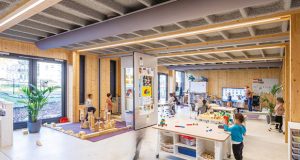 Two in five people have found themselves engaged in workplace-based conflict over office temperature. Jason Webb, Managing Director at Electronic Temperature Instruments outlines the legal requirements, the standards, and the measures needed to provide optimal comfort
Two in five people have found themselves engaged in workplace-based conflict over office temperature. Jason Webb, Managing Director at Electronic Temperature Instruments outlines the legal requirements, the standards, and the measures needed to provide optimal comfort
Legally, there is no mandated required temperature for an office. What is advised, however, is a recognised health and safety authority agreement stating that a reasonable temperature would be considered above 16 ºC. In this agreement, there is no recommended maximum temperature, however studies have found that temperatures in the area of 23-24 ºC and above sees a dip in productivity from employees. The most optimum temperature for sound productivity was advised in the region of 20 ºC.
Office and facilities managers do not escape all responsibility. Health and Safety at work law does have broadly stated requirement for employers to keep the workplace comfortable. This includes things such as temperature, air quality, and natural light, amongst others. Failing to provide these requirements can be a breach of employment law and leave the business open to reports and complaints from employees, potentially resulting in legal action and sanctions and fines.
Adherence to these standards not only meet legal requirements and health and safety advisory, but also helps nurture a happy, healthy and productive workforce, displaying strong wellbeing principles.
FACILITIES MANAGER’S ROLE IN ASSURING COMFORT
Facilities Managers play a significant and crucial role in ensuring that a workplace is kept comfortable, from both a temperature perspective and wider environmental factors. Heating, ventilation, and air conditioning (HVAC) systems are a key factor in the quality of comfort within a working space. Ensuring that these are properly maintained, serviced, and calibrated to provide a comfortable temperature throughout is a core responsibility that FMs should be routinely undertaking.
Equally, having an open and frequent open dialogue with the occupants of the facility being managed is essential to understanding their needs and requirements in order to deliver what they believe to be the optimum comfortable temperature for work. Providing the technology and equipment is of course a vital part, but understanding the needs of the occupants humanises the requirement and can lead to better conditions for all.
After reviewing the data on temperature’s impact on productivity and ability to work, it is safe to say that a poor relationship, inability to be contacted or lack of understanding of requirements can make or break a working day for many businesses. As an FM you must think two steps ahead, meaning that proactive action and reviewing means less time and energy being spent on the reactive. Understanding the site through a sound knowledge of space planning means that areas with hot or cold spots, poor airflow, lack of natural light or where the heat or cooling is coming from, all result in different adaptive measures needing to be undertaken.
There is no one-size-fits-all approach to every office, facility or working space. FMs must understand the needs and requirements of each space individually and assess the best means of ensuring comfort.
TECHNOLOGY FOR TEMPERATURE MONITORING AND CONTROL
There are a number of technologies available for delivering, monitoring and adjusting to temperature. Placing the accessibility in the hands of the user, with a sound level of displayed information, allows for a proactive level of control with the shortest response time.
The factory act thermometer is a cost effective and classic piece of equipment that offers a simple, easy to read option ideal of office spaces. 16 °C is the suggested optimal lowest temperature for an office, so you can easily visually see if conditions drop below the recommended temperature.
A digital max/min is a handy piece of thermometer equipment that displays the highest and lowest temperatures over a period of time, giving a clearer idea of conditions throughout a working day. This thermometer displays the maximum, minimum, and current temperatures simultaneously, meaning that predictive and reactive measures can be made in time to maintain a comfortable and optimum temperature.
For a more rounded understanding for the comfort of an office space, having both the temperature and the humidity allows for some of the fullest understanding and readability of conditions. Comfort thermometers displays both temperature and humidity, along with the option to view max/min temperatures. Humidity plays a large role in the air quality, especially in somewhere such as an office space. Having this rounded level of information at your disposal helps ensure that optimal temperatures and space quality is being maintained and adhered to continuously.
CONCLUSION
Office temperature, and the conflict that can sometimes ensure from it, requires a balanced approach and consideration of both legal requirements and employee wellbeing. While there is no mandated set temperature, there are health and safety guidelines that set clear goalposts for comfort in a working environment – and those do have a legal basis.
FMs have a vital reasonability to ensure that systems, technology and an open dialogue are maintained and accessible, if not, productivity has had a proven impact. Office temperature requirements can only be balanced when a sound understanding of the rules, requirements and people’s needs are holistically taken into consideration.
In association with https://thermometer.co.uk





